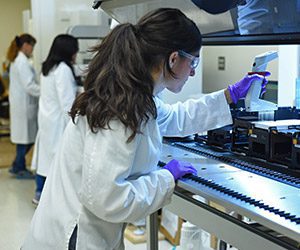When most people hear the term “infectious disease,” it’s likely they think of illnesses that have been prominent in the news lately, such as Zika virus, MERS and Ebola. But there is a disease that poses a much broader and more imminent threat to most of us: influenza.

Seasonal influenza viruses infect five to 20 percent of the population annually and cause an average of 36,000 deaths in the United States alone each year. While flu vaccines have helped reduce the rate of infection since their introduction in 2012, their effectiveness is limited due to continual changes in the circulating virus. In addition, vaccines take eight months to a year to develop. In a pandemic situation, this is much too long.
We need a reliable second line of defense against flu. Effective anti-flu medications that can be given to those who are most vulnerable to serious infection, such as the elderly and young children, will save lives and prevent further spread of disease in the event of a serious outbreak. There are currently just two, approved anti-flu medications on the market and, unfortunately, neither is particularly effective.
In 2007, Robert Webster, who is a globally renowned influenza expert asked me, “Shouldn’t medicinal chemistry be able to do more to treat flu?”
That year, I began research to explore where the influenza virus might be vulnerable, with the hope that this work would one day lead to an anti-flu medication that was effective and, importantly, wasn’t susceptible to the mutations the flu virus cleverly develops to out-maneuver available medications.
Over the past eight years my collaborative research teams have made steady progress – learning more about the structure of the flu virus, how it infects human cells, how it becomes resistant to medications and, ultimately, how we might stop it. Recently, the Proceedings of the National Academy of Sciences (PNAS) published a paper highlighting several important new discoveries made by researchers at SRI International in collaboration with colleagues from St. Jude Children’s Research Hospital.
These discoveries center around an enzyme called the endonuclease, part of the flu virus machinery that helps the virus replicate. By way of the endonuclease, the flu virus clips off the end of the host cell RNA, attaches a corrupt message, and then returns the cap to the host RNA. This is a sneaky practice fairly unique to influenza virus known as “cap snatching.”
In our most recently published research, the joint SRI-St. Jude team investigated a compound that initially demonstrated the ability to block the function of flu virus endonuclease. In addition to exploring the effectiveness of this compound (L-742,001) for treating flu, we wanted to learn more about how and where the flu virus endonuclease develops resistance to potential medications.
In our first round of experiments, we found that the flu virus could not develop resistance to L-742 in a test tube. This was good news, but was also surprising and created challenges for our project, because we wanted to investigate how resistance to flu medications emerge via the endonuclease. So, the research team artificially created virus with mutations throughout the endonuclease. We then looked at which mutations resulted in resistance to L-742. Knowing the viral endonuclease regions where resistance can emerge to medications that are initially effective will help us identify compounds that avoid these regions and, thereby, don’t lose effectiveness over time.
Based on this breakthrough research, our team at SRI is now working to identify new influenza drug molecules that will block the endonuclease function while simultaneously avoiding the emergence of resistance. SRI has extensive depth in infectious disease and anti-viral drug discovery that will expedite our work: We already have significant details about small molecule structures that bind to endonuclease and have come to know this interaction like “the back of our hand”, and so we are on a path to identify and develop much more effective flu drugs. In the case of a pandemic or bio-threat, medications based on these recent endonuclease discoveries could save millions of lives worldwide.
Many thanks to the SRI team members who contributed to the latest findings published in PNAS: Wei Zhou, Ph.D., a coauthor on the paper who managed the biochemistry aspects of this project; Diane Beylkin, Ph.D., who is managing important chemistry work that is moving the project forward; and Jaehyeon Park, M.S. and Chandraiah Lagisetti, Ph.D., who are providing invaluable support for the chemistry work.
Research reported in the publication was supported by the National Institute of Allergy & Infectious Diseases of the National Institutes of Health under Award Number R01AI098757. The content is solely the responsibility of the authors and does not necessarily represent the official views of the National Institutes of Health.


